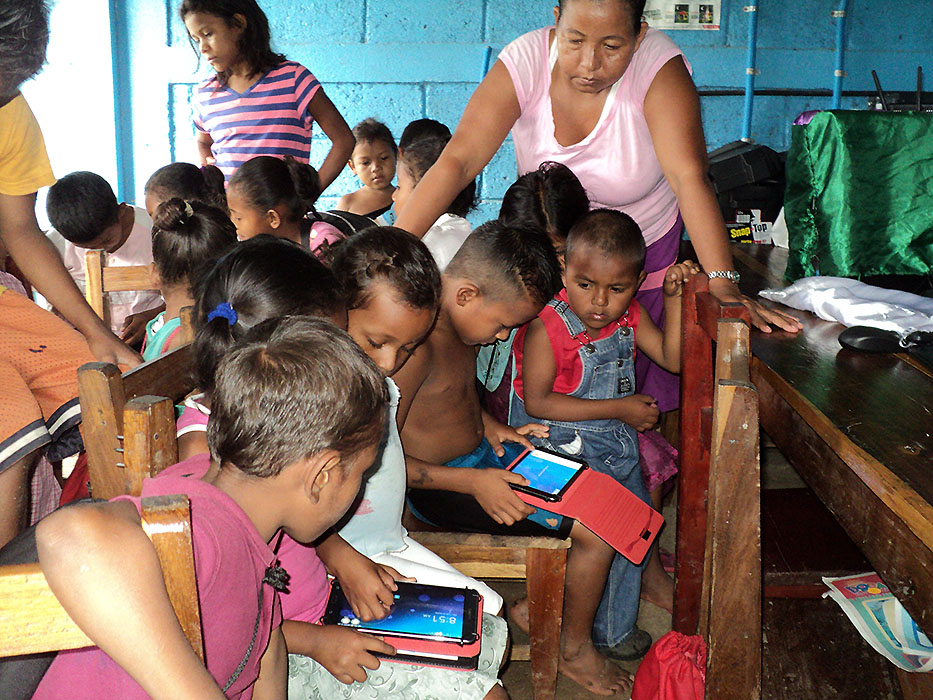Bridging the digital divide in Nicaragua's remote regions
Context: Digital divide
Start date: 01/01/2015
End date: 20/03/2018
Areas of intervention:
- 4 communities in the RACCN
- 3 communities in the Madriz department
Activities:
- Digital educational classroom
- Internet access
- Provision of digital educational content
- Emergency satellite line
1,571 student direct beneficiaries
1,231 family indirect beneficiaries
4,672 minutes of calls
Context
The Autonomous Region of the North Caribbean Coast (RACCN) was integrated into Nicaragua at the end of the twentieth century due to various foreign controls between 1650 and 1860. For this reason, Nicaragua's largest region remains distinctly isolated. This isolation is reflected in a significant lack of infrastructure and basic services (drinking water, electricity, sanitation and communications), but also by low investment, public insecurity and a fragile institutional framework.
The RACCN is originally populated by multilingual indigenous communities (Miskitus, Creoles, Mayangnas, Ramas and Garifunas) and have a strong sense of attachment to their now threatened land.
The average poverty rate of the region is 68.8%, 10 points higher than the national average. The illiteracy rate among the population aged 10 and over is 43%, up to 55% in rural areas, and even higher among the female population, whereas the average for the country is only 24.5%.
Implementation
The NGO Plan International Nicaragua (PI-N) has implemented projects in the RACCN since 2012 addressing the indigenous Miskito communities with a community development approach focused on early childhood.
As part of a collaboration agreement, PI-N and Télécoms Sans Frontières from its America regional base, set up a pilot project using ICT to provide support in education and training courses to drive the fight against social isolation
TSF conducted a feasibility study to develop communication and information solutions to improve the quality of education and open these communities to the outside world. At the beginning of 2015, the pilot project was launched in Tasba Pain, a village of 603 people on the northern edge of RACCN, where the nearest mobile connection was 7 km away and the download of data was only possible 70 km away. In 2016, the project was extended to three other communities in the RACCN and three communities in the Madriz department.
Digital educational classroom
Pilot project in Tasba Pain (since January 2015)
The project proposes the creation of an educational classroom equipped with new technologies enabling access to information on topics related to education, health and protection for girls and boys.
PI-N built the room and provided a central server (CPU) connected to five terminals and a projector. TSF supplied eight digital tablets, a multifunctional printer and a satellite connection. TSF has also made available resources shared on local network, including the Wikipedia online encyclopedia and a digital library.
The latter was created internally to adapt the educational content developed by PI-N to tablets and on the system terminals connected to the server. The content is made up of collections on the themes of child protection, education and early childhood, sexual and reproductive health, social services etc. New collections can be added easily by the group leader.
Internet access allows basic use such as email, local news sites, and library content updates, and also allows for emergency phone calls. Satellite equipment enables voice and data communications for community emergencies, with the goal of ensuring medium and long-term project sustainability while reducing communication costs.
TSF provided training in technical support for the centre's administrators. The classrooms are equipped with solar panels that allow three days of autonomy in the event of a power cut. An economic system has been put in place with the offer of digital services (cybercafé, printing, and scanner) at reduced cost to ensure the centres sustainability and independence.
The classroom benefits the whole community - local school children, students, teachers and educators from the city and the surrounding area. A total of 148 students (79 girls and 69 boys), along with nine teachers and one nurse, participated in these community-based projects using technology. 3,349 minutes of community calls have been made since 2015.
In 2016, the project was backed by the Spanish Cooperation, which financed the expansion in six communities of the RACCN and the department of Madriz.
Entrepreneurship and Digital Learning Project (20/11/2016 – 20/03/2018)
The objective is to improve living conditions through an affordable and inclusive ICT service, benefiting children, adolescents, youth and their families from the Miskita ethnic group of RACCN and the rural populations of the department of Madriz, respectively:
- Kum, Santa Clara, Francia Sirpi, from the RACCN department;
- The Carbonera, El Tamarindo, Motuce in the department of Madriz.
There is a significant difference in Internet access between Madriz, where 3G arrived in 2017, and the RACCN, where satellite connectivity is still the only available option. To date, only one of the RACCN communities participating in the project has access to 3G. For the RACCN communities, the Internet remains an emergency and priority information solution.
The digital classrooms were designed as community spaces annexed to the local school. Equipped with computers, they offer a series of information services and technological knowledge. A satellite connection provides daily access for data download and phone communication capability, as well as mobile charging and printing and scanning of documents. The rooms are equipped with solar panels to enable autonomy when electricity is down.
The services offered and the pricing model enables to cover maintenance and expenses while creating jobs for locals.
These digital activities benefited 1,423 students (546 girls and 877 boys). 1,323 minutes of priority calls for the community were made between 20th November 2016 and 20th March 2018.
















